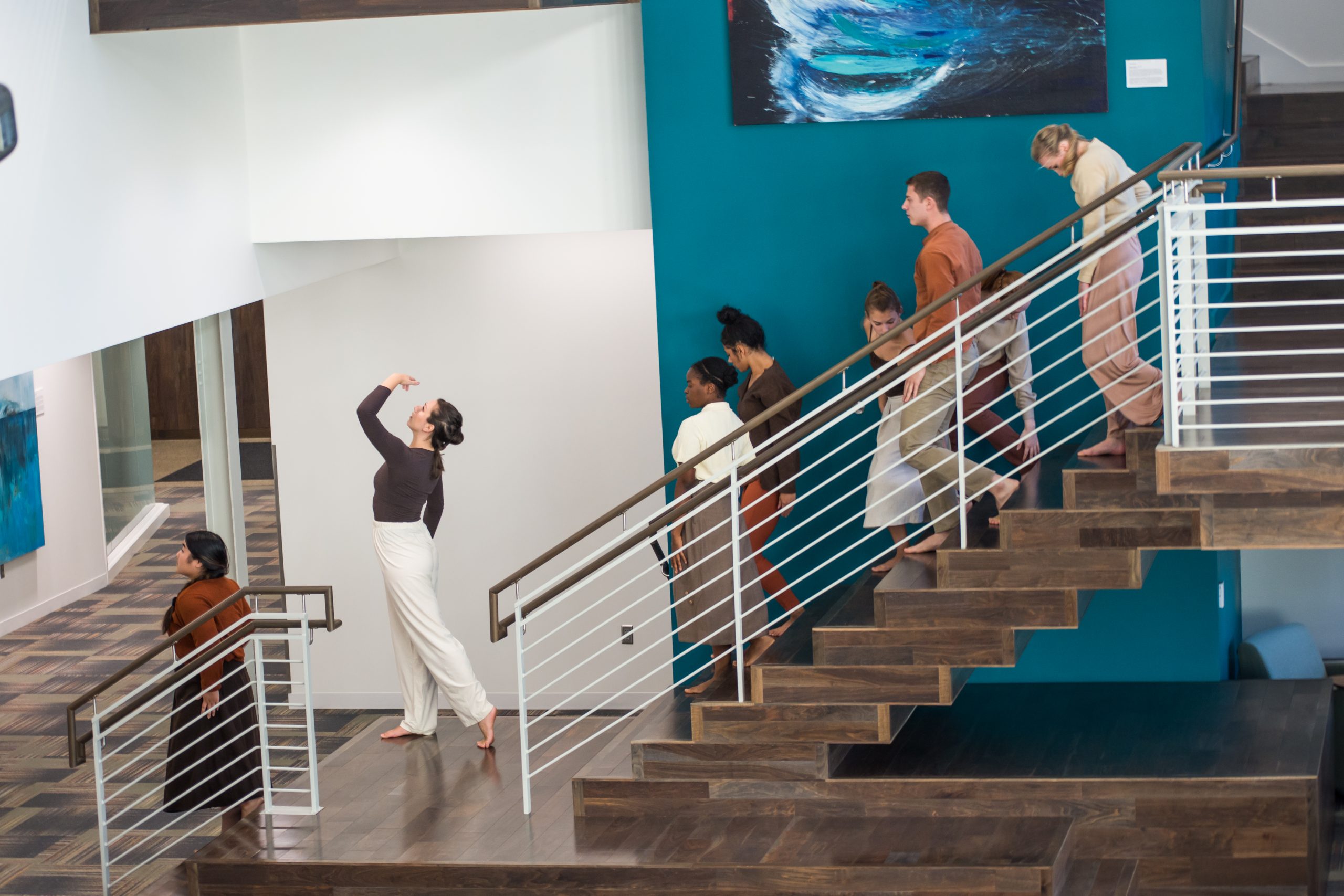As part of the celebration surrounding the 53rd Nobel Conference, Reproductive Technology: How Far Do We Go?, senior dance and philosophy major Allison Retterath choreographed Out, Behind, Overlooked to explore the balance between rapidly advancing technologies and inequities in availability. The piece was created through research, discussion, and movement exploration. Each dancer that participated in the piece played a vital role in the creative process.
Here, Retterath explores the concept, creation, and execution of the piece.
I developed Out, Behind, Overlooked for Nobel Conference 53 with the hopes of portraying the ethical implications of reproductive technology through dance. Translating such a large, complex topic into movement involved a lot of abstracting. Although dance is traditionally described as a medium in which movement tells a story, I believe dance is more about communicating a small essence of a larger whole—with the larger whole in this case being reproductive technology. However, in order to get clear about what that essence is, I first had to narrow down exactly what I was trying to communicate.

I began the research process by gathering books written by the speakers in the Nobel Conference. I was especially drawn to Dr. Ruha Benjamin’s book, People’s Science: Bodies and Rights on the Stem Cell Frontier. I was particularly fascinated with how Dr. Benjamin challenged the dualistic nature of debates surrounding reproductive technology. She highlighted the complexities of reproductive technology traditionally considered relevant only in a scientific context. Rather than discussing reproductive technology in a purely scientific manner, Dr. Benjamin argues for a social reading of reproductive technology that emphasizes inequities in both development and access. She ultimately humanizes reproductive technology, which is a natural consequence of communicating reproductive technology through human bodies in dance.
After reading Dr. Benjamin’s work, I decided to focus on communicating the concept of making decisions—of being forced to choose when you have limited options and people influencing what ultimately should be a very personal choice. Every person using reproductive technology has a different social history and experience with the technology that shapes their decision-making. Additionally, portraying a lack of equitable say in what technologies are developed, how those technologies are used, and who has access to those technologies was a fundamental goal in the creative process.
In addition to using Dr. Benjamin’s research surrounding the social concerns in reproductive technology, the performance space itself had a huge influence on the development of Out, Behind, Overlooked. Anderson Hall is made up of multiple platforms at different heights, a staircase with two different offshoots, and a counter space across from the stairs. Although I originally planned on using just the main staircase, the diversity of locations offered too unique of an opportunity to pass up.
The ability to use the different spaces in Anderson Hall was instrumental in the spatial portrayal of the difference in experience between dancers. While a dancer performed a solo on one of the lower platforms, a trio stood at the highest platform quite literally looking down on her. The shallow counter space provided the spatial manifestation of feeling as if you don’t quite have enough room to make a decision. The dancers, either as a solo, duet, or trio, performed individually in different areas of the space.

Each grouping portrayed different aspects of the overall concept while simultaneously showing the multiplicity of experiences with reproductive technology. Just before a grouping completed their movement, the next grouping would begin. The transitions between each grouping involved a sense of observation carrying judgment of some sort. The dancers looked in on the experience of the others, not quite seeing the whole story, yet choosing to pass judgment or ignore one another.
When the individual groupings were finished, all of the groupings returned to their corresponding areas in the space and repeated their movement with more urgency and skipping certain movements. This condensed, second-appearance of the groupings provided a sort of summary of their experiences. The simultaneous performance of each grouping showed how all of these individual experiences happen at the same time: we all have different stories and experiences even though we are living in the same world in the same time.
Another mode of showing the dancers’ differing experiences within the same world was the costuming. All of the costumes matched in terms of color scheme and general style, but the costumes themselves differed greatly. While some dancers wore long pants and long-sleeve shirts, others wore skirts and sleeveless shirts. Although every dancer’s costume fit together, each individual was different—showing how reproductive technology affects people differently depending on their identities and experiences.
The costuming, use of space, and movement reflected the multiplicity of experience involving reproductive technology. Ultimately, Dr. Benjamin’s work inspired the creation of a piece focused on the application of a broad scientific topic onto the lives of people. My project was one of humanization—an attempt to put a face on the differing experiences of people affected by a narrowly viewed science.
Allison Retterath is a senior dance honors and philosophy double major from Rosemount, Minn. She is especially intrigued by feminist philosophy and American Pragmatism, and enjoys exploring how those facets of philosophy intersect with movement and choreography.

Leave a Reply
You must be logged in to post a comment.